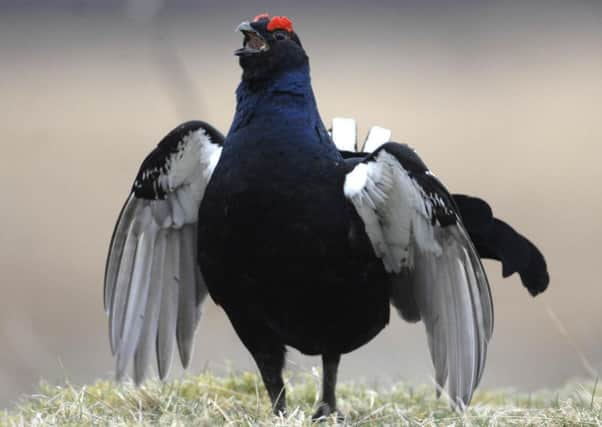Adam Smith: We'll get Scotland's black grouse flying high again


The black grouse (Tetrao tetrix) is a charismatic bird – larger than its red counterpart. The male isglossy black with lyre-shaped tail, a distinctive red wattle over the eye, white under the tail and a white flash on its wing. The less exotic female is mottledgrey-brown.
Black grouse were once so widespread they were said to be present in every county in Britain, but they have been in decline for more than 150 years. This is due to a combination of factors including the loss and fragmentation of moorland and moorland fringe habitats through agricultural improvement and commercial afforestation, and increases in generalist predators. Two thirds of the remaining 5,000 males are now found in Scotland, with 1,000 in northern England and 400 in Wales.
Advertisement
Hide AdAdvertisement
Hide AdWhilst numbers of black grouse in the Scottish Highlands are considered stable, numbers are struggling though the Scottish Borders and Dumfries and Galloway, where some stability would be expected.
The Game & Wildlife Conservation Trust (GWCT) has demonstrated through a recovery project in northern England that the declines can be stopped and numbers increased, but this requires a landscape scale approach, where neighbouring moorland land managers implement a suite of conservation measures on the moor fringe.
The focus is now on the south of Scotland, with the launch of a new conservation plan in early July at the GWCT Scottish Game Fair outlining necessarymanagement approaches to stop the decline in this region, then increase numbers and encourage recolonisation of lost range.
Black grouse conservation in southern Scotland – Phase 2 development of a regional strategic conservation plan has been funded by project partners GWCT, Forestry Commission Scotland (FCS), Scottish Natural Heritage (SNH), the Lammermuirs Moorland Group, Scottish Borders Council and RSPB Scotland
A number of priority actions have been set out in the plan that aim to reverse the longterm decline of black grouse in the region. This has accelerated in recent decades, with numbers falling by 49 per cent and 69 per cent in south-west and south-east Scotland respectively between 1995-6 and 2005, to an estimated 807 and 257 males. The new plan follows an earlier desk-top project in 2013-14 that looked specifically at the size and management of moorland areas and how this affected black grouse occupancy and numbers. This concluded that to conserve black grouseeffectively in southern Scotland a landscape-scale approach was required, with its fundamental objectives being to secure and protect core populations associated with the larger moorland areas, prior to instigating measures to increase population size and the connectivity with other moorland in the landscape.
At the launch, Fergus Ewing, Cabinet Secretary for Rural Economy and Connectivity, said: “Black grouse are among Scotland’s most iconic and impressive species but I am aware numbers in southern Scotland have fallen in recent decades. To halt this decline, it is therefore vital that we work together to take the right conservation action in the right places.”
The new plan outlines a number of priority actions – short, medium and long term – covering areas including Tweedsmuir and Langholm, the Moorfoot Hills, Galloway Forest Park south to Cairnmore, the Muirkirk Hills, East Galloway, the Lowther Hills, the Lammermuir and Pentland Hills, and the heathland network east of Craik Forest.
Actions include enhancing habitat on the moorland fringe through appropriate grazing management and targeted broadleaf planting, in combination with predator management. This will be targeted to retain and consolidate the connectivity between moorland areas.
Advertisement
Hide AdAdvertisement
Hide AdDr Philip Warren of the Game & Wildlife Conservation Trust, and author of the plan, said: “This strategic plan provides an important platform for all parties to deliver black grouse conservation objectives in southern Scotland. In the short term we need to target resources to secure remaining populations whilst in the longer term putting in place a network of habitat corridors to enhance connectivity and facilitate future range colonisation.”
The Lammermuirs Moorland Group has also helped with funding because of its members’ strong desire to see black grouse flourishing again in the Lammermuir Hills. Evidence from the north of England shows a close correlation with red grouse management, particularly predator control. The grouse moor estates in the Lammermuirs can provide practical input to help range recolonisationfrom the Moorfoot Hills and will be working with GWCT and other partners on delivery of the conservation plan.
• Adam Smith, Director Scotland, Game & Wildlife Conservation Trust
• The full plan is at www.gwct.org.uk/blackgrouseplan